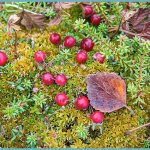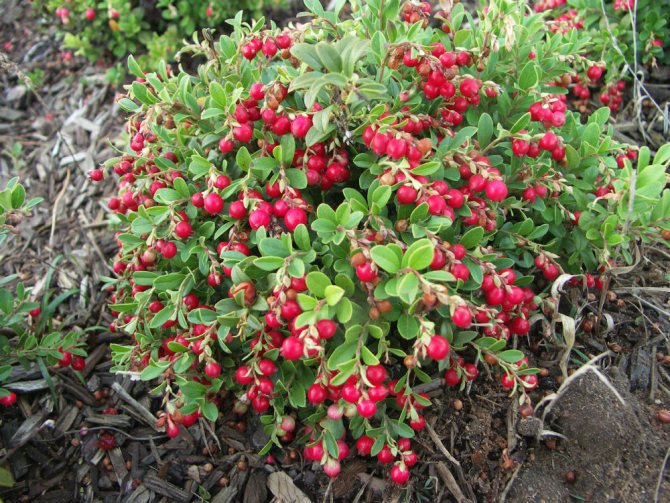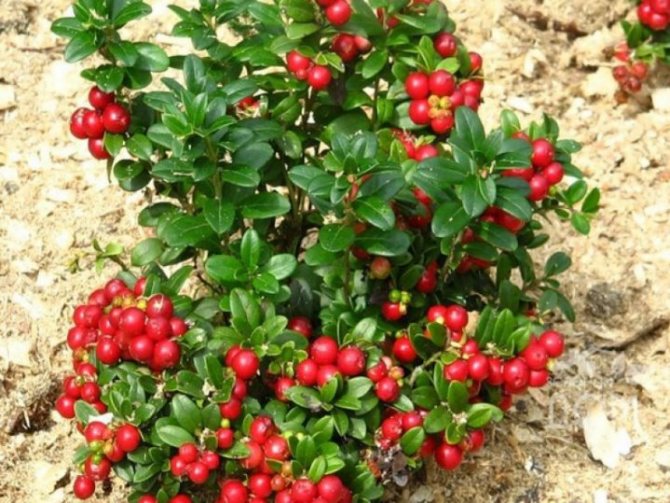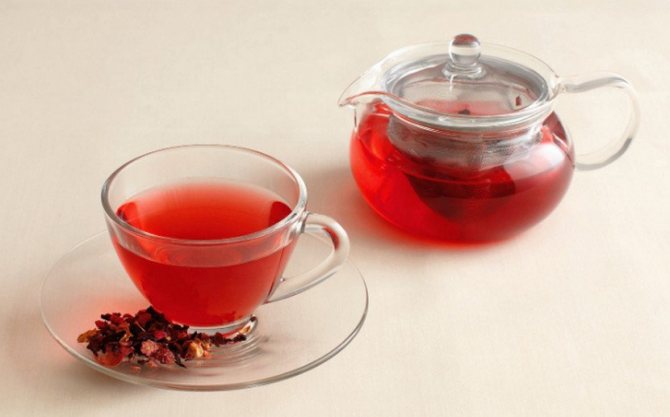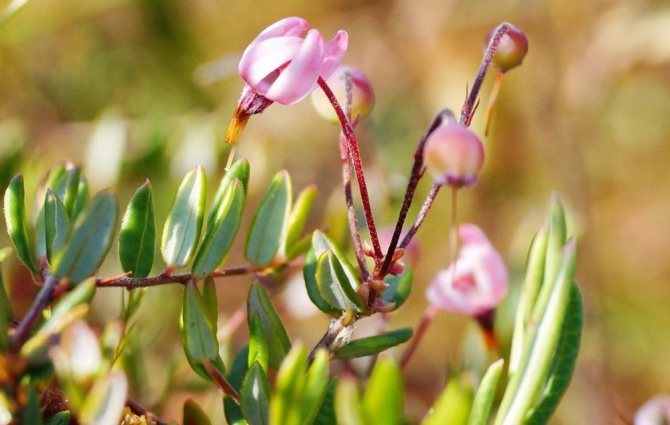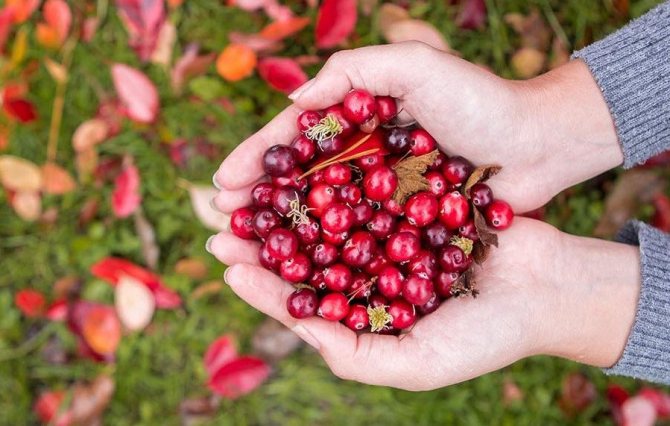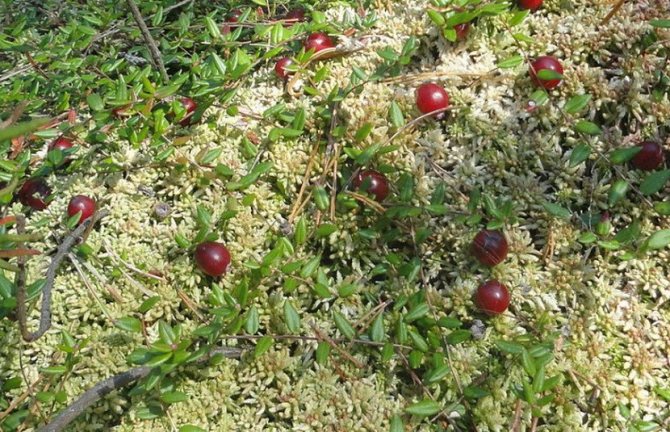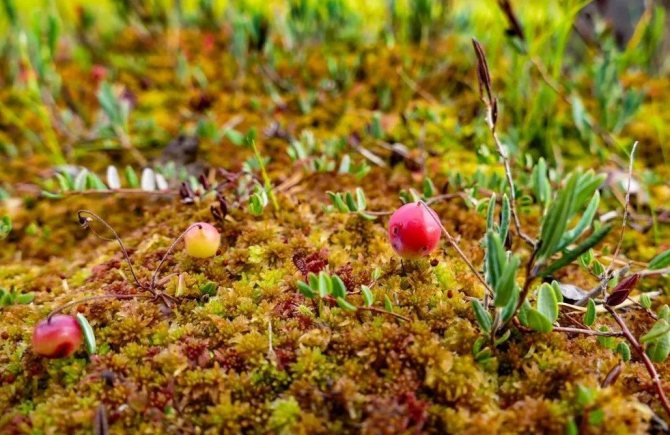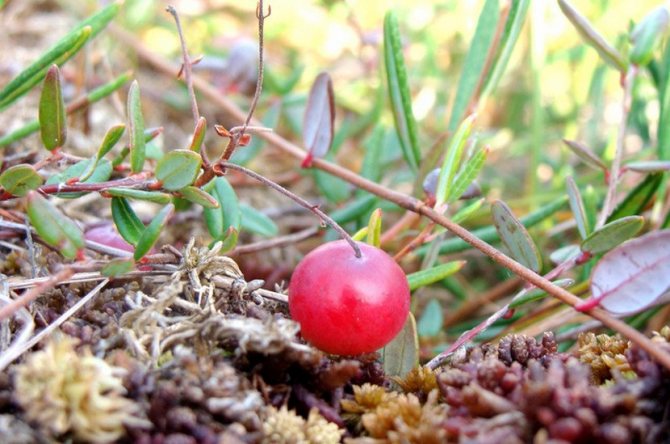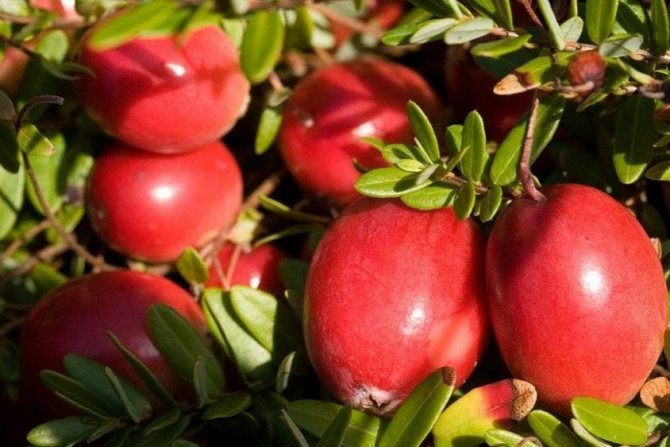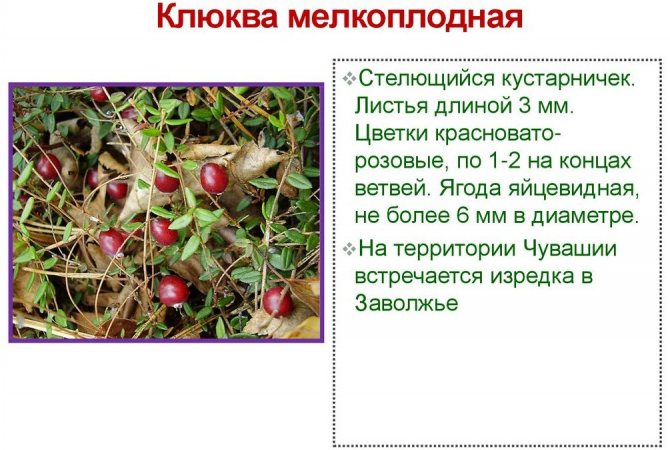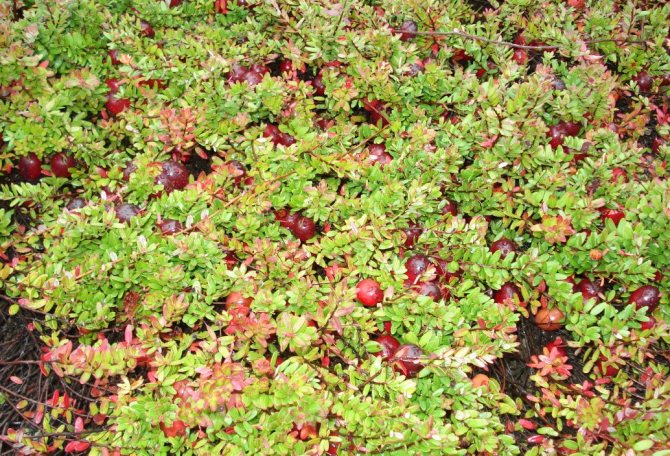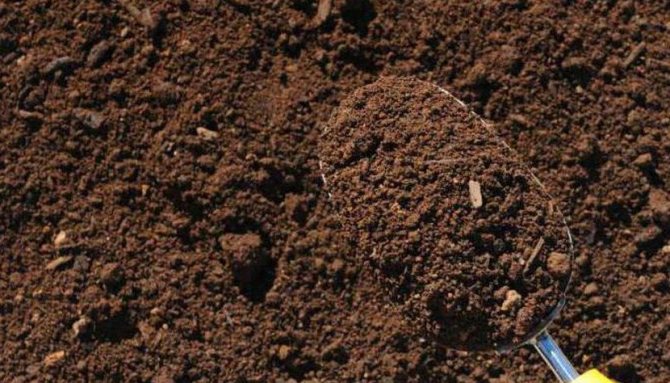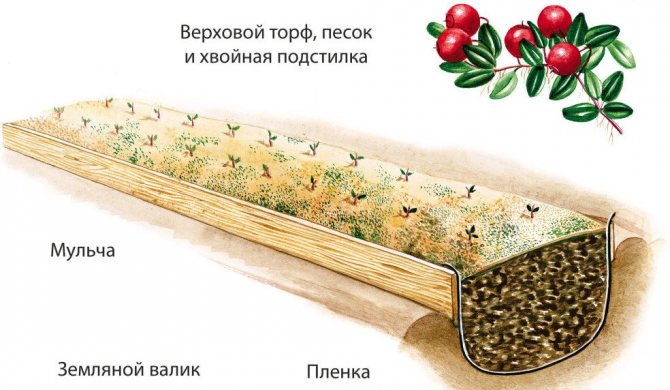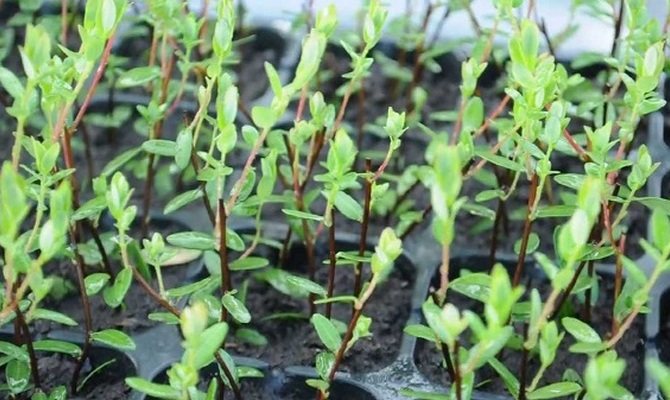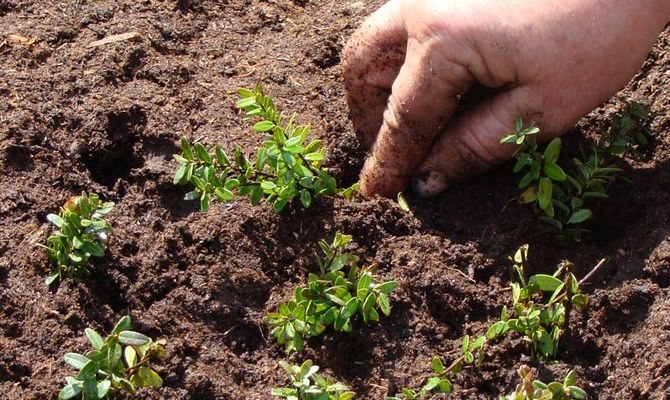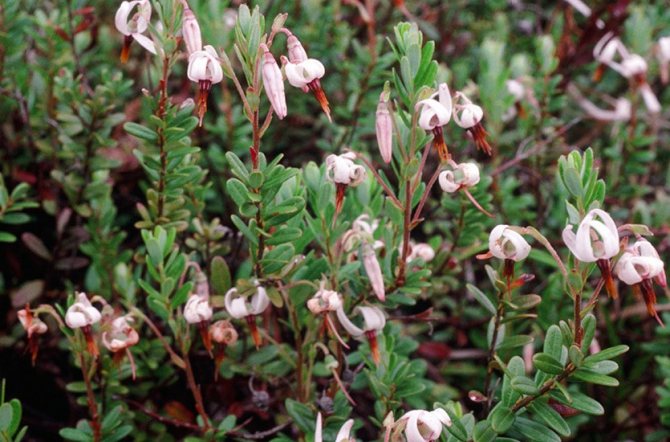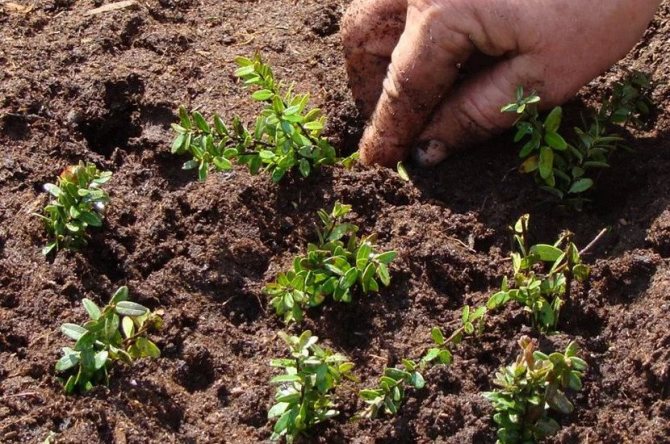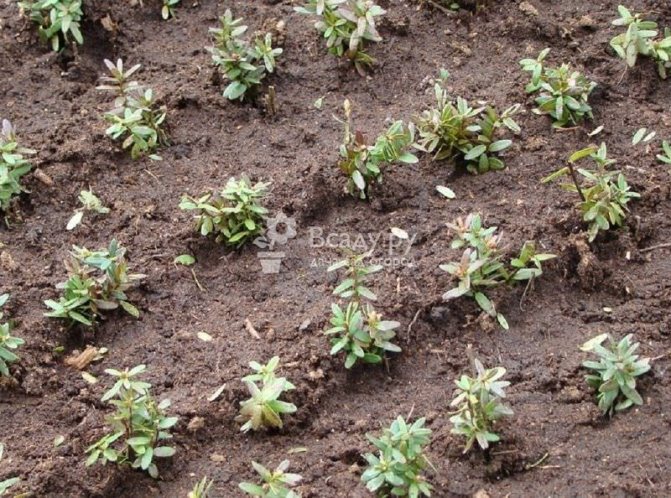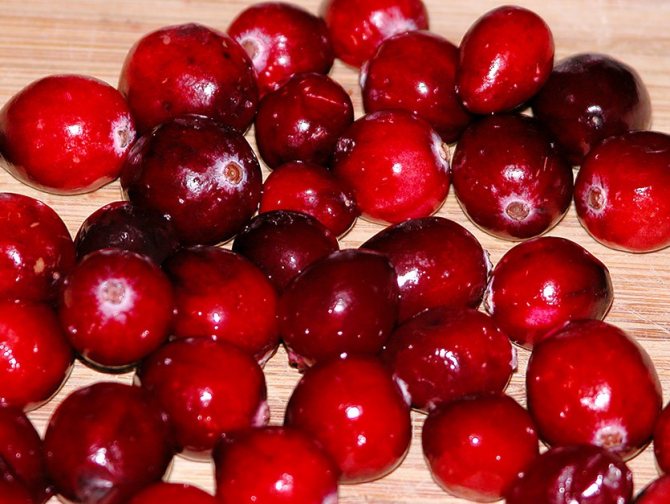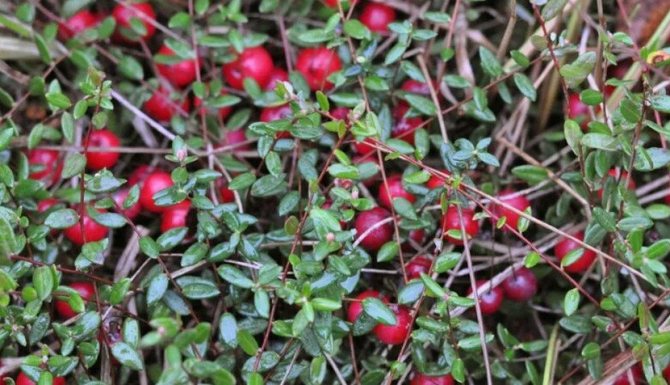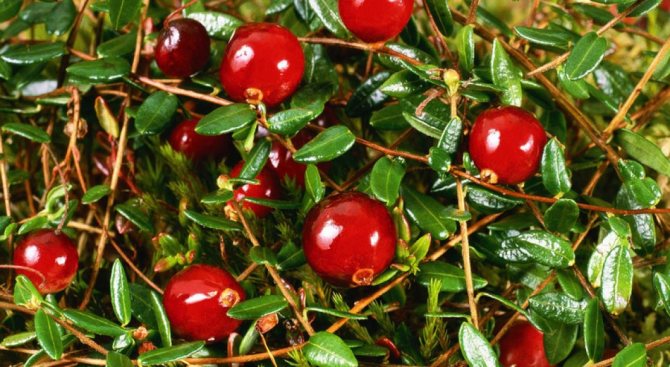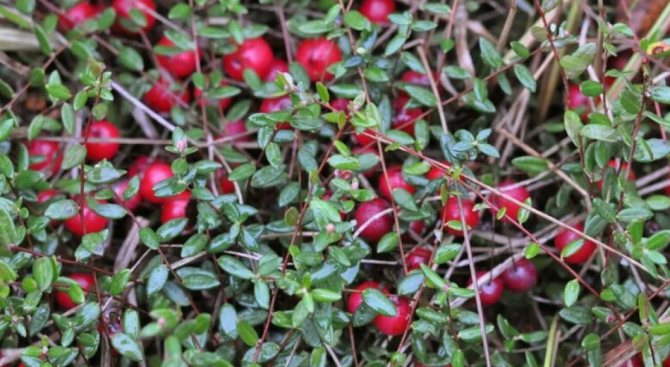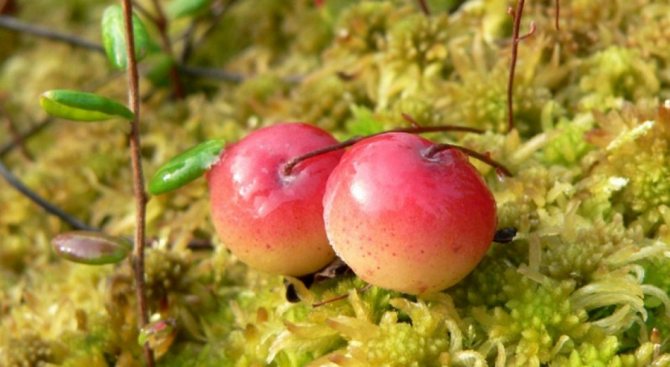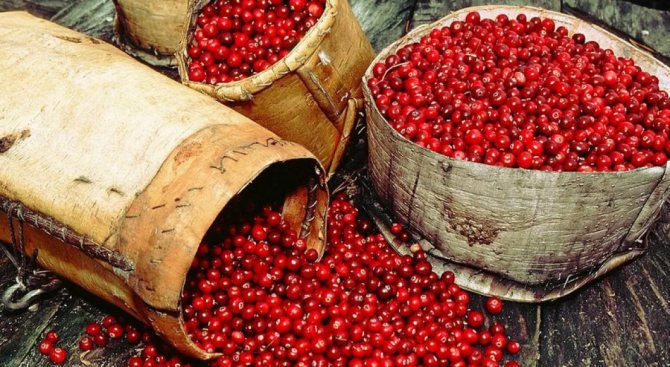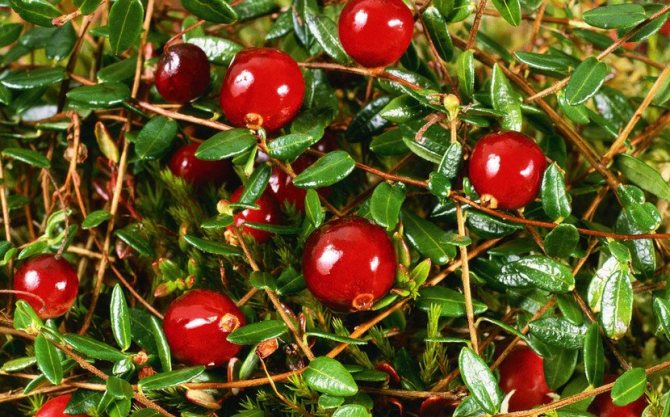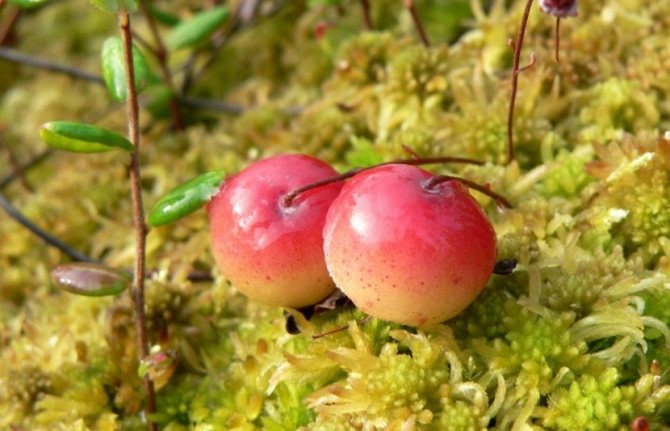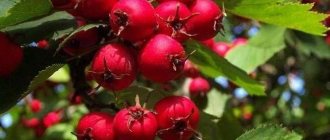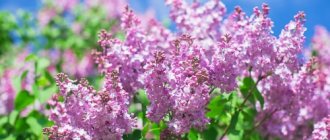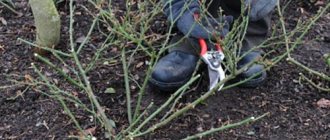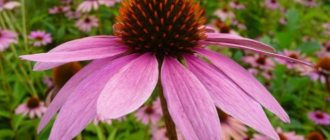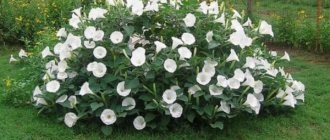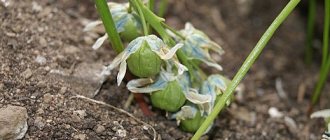Cranberry, according to scientific interpretation, means "sour berry". In their natural environment, cranberries grow exclusively in humid conditions: in a coniferous forest, in a swamp, etc. This plant is a storehouse of vitamins and microelements necessary for humans, and it is not so difficult to grow it outdoors. Today we will tell you about the main varieties of garden cranberries and the peculiarities of their cultivation: planting in the ground, care, etc. ...
Cranberries: general information, main varieties and varieties
Cranberry is a plant with evergreen bushes reaching a height of half a meter. The culture has a pivotal root system. Oblong leaves are located on small petioles. Cranberry fruits are small sour red berries (up to 1.5 cm).
Garden cranberry is a very popular berry in the fruit and vegetable market and its price is very high. This is not surprising: cranberries have amazing medicinal properties and are used to treat vitamin deficiency, vascular and gastrointestinal diseases, remove heavy metals, toxins from the body and slow down the aging process of the body.
There are several varieties of cranberries, but large-fruited and marsh cranberries are mainly used in the agricultural industry. The most popular varieties of the first variety include the following:
- Ben Lear. An early ripening variety with excellent yields. The berries are of a considerable size, tasty, but, unfortunately, they are not stored at all, so they must be processed or frozen immediately after harvest.
- Searles. A high-yielding variety that produces large berries (deep red color). Stores well.
- Stevens. This variety is considered one of the best in its variety. It keeps well and gives a very high yield of large berries of deep red color.
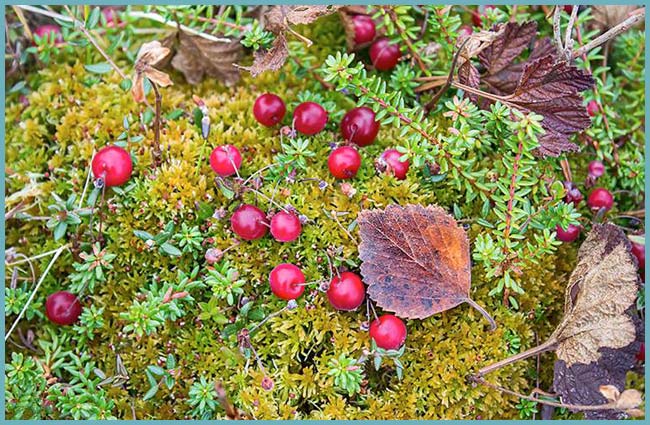
Ripe cranberry
Marsh cranberries are native to Europe. There are many varieties of this variety. The most popular of them are:
- Sominskaya. A high-yielding variety that produces large, bright red fruits of an asymmetric shape with a slight acidity.
- Gift of Kostroma. It is a high-yielding mid-early variety that produces large, juicy cherry-colored fruits with a flattened shape.
- Beauty of the North. This variety is late ripening (yields a harvest somewhere in the middle of September). Fruits ripen large, carmine color.
Why plant cranberries on the site?
Many people believe that in order to grow this berry, it is necessary to breed a swamp on their site. This opinion is erroneous, although this culture prefers peat soil. In nature, it can be found in the northern and central regions of our vast country. Kamchatka, the Far East, Siberia and Sakhalin are all habitats of evergreen shrubs. The plant is unpretentious to care for, but you need to take into account its peculiarity - the love of a well-humid area. The shrub absorbs vitality, vitamins and minerals from soil fungi that form on its roots. A loyal attitude towards transplants also belongs to the merits.


Garden cranberry
It should be said right away that the fruits are unlikely to surprise with their taste, but they are famous for their healing properties. Cranberry juice is the first helper in the treatment of viral diseases. It is recommended to take these fruits to improve digestion, they contribute to the production of gastric juice.Thanks to the latter property, cranberries are used to treat gastritis. It is worth noting another diuretic effect and the ability to protect the genitourinary system from various infectious diseases. Increasingly, doctors claim that this product is an excellent tool for the prevention of cancer.
Red fruits are rich in vitamins and antioxidants, they contain almost all useful substances, malic, citric, oxalic and other acids. The pectin content is also quite high. The list of trace elements is also very wide, among which potassium, calcium and phosphorus occupy the leading positions. Cranberries are eaten both fresh and dried. Jam is made from it, compotes, fruit drinks are cooked, and various tinctures are made. At the same time, the useful properties of the product are preserved in any form.
However, shrubs are planted in areas not only because of the miraculous berries, they also differ in decorative properties. An evergreen plant with thin, low stems, beautiful pink or purple flowers are covered at the end of May. But you can enjoy the fruits only in September. And do not rush to harvest, the berries can be preserved even under a layer of snow. Usually the size of the fruit does not exceed 12 mm in diameter. However, there are also bred varieties with berries of about 20 mm.
Planting a plant in the ground
In nature, cranberries grow mainly in humid places: along a reservoir, in a coniferous forest, etc. Accordingly, for its cultivation in the country, you will have to create similar conditions. First, the place should be open, with good access to light and close groundwater. The ideal option is a place near a summer creek or a headquarters. A shadow, for example, from trees growing nearby, will not be superfluous.
The cranberry bush is very fond of acidic soil. Peat bog or forest soil mixed with moss is perfect. If your soil is not the same, then you will have to try: remove the soil about 25 cm deep and fill it with a mixture of peat, earth and humus from the forest, as well as sand (2: 1: 1: 1).
Advice. Experienced gardeners know one little trick that helps to improve the growth of cranberries - just add some pine needles to the soil. The cranberries will only be grateful to you.
Cranberries are planted in early spring, when the ground thaws to a depth of about 10 cm, but it is necessary to prepare the soil in the fall (before the onset of the first cold weather). Try to enclose the planting site with non-rotting material - slate, plastic, etc. Dig in the "fence" to a depth of about 20 cm, and it should rise upward at the same distance.
Before sowing, it is necessary to dig holes in the soil 10 cm deep, keeping a distance of at least 15 cm between them and fill them well with water. In each you need to put a pair of seedlings about 15 cm high and carefully cover the holes with earth, but not compact them. You can get the first berries already three years after planting the plant. And you will harvest a big harvest in another year.


Place for planting cranberries
Recommendations for growing in the Moscow region
Agricultural technology for growing cranberries in the Moscow region is not much different from the generally accepted rules outlined above. It is worth noting here the need to shelter shrubs for the winter, since winters are quite cold, but with little snow, as well as monitoring soil moisture in hot summers.
Read about the beneficial and harmful properties of cranberries for men and women.
Particular attention should be paid to the choice of seedlings for planting, or rather, varieties. The best choice for this climatic zone will be large-fruited early-maturing varieties (Stevens, Franklin, Pilgrim), which bloom in June, so there is no risk that the crop will suffer from spring frosts. The crop is harvested at the end of September, after which there is enough time to prepare the plant for wintering.
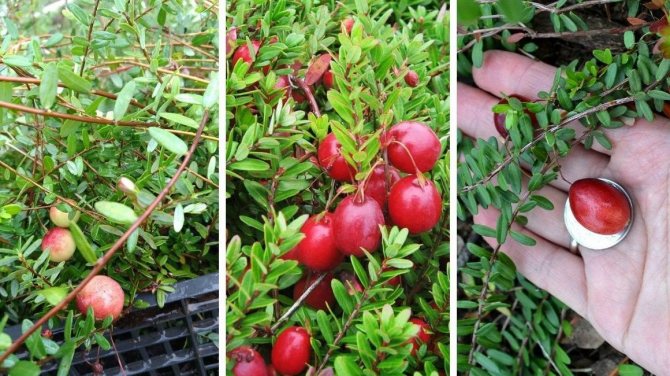

The undoubted advantage of planting cranberries is the significant benefits of its fruits for the human body. It is also worth noting the long duration of the culture's life - in one place it can grow up to 20 years, and after transplanting, continue to delight its owners with decorativeness and harvest.
Features of caring for cranberries
Growing cranberries is pretty easy. The main thing is to timely carry out standard measures for the care of crops growing in open ground: weeding, watering, etc. But first things first.
To achieve active growth of cranberries, it should be watered abundantly for the first 10-14 days after planting. Over time, when the first shoots sprout, it will no longer require so much water. It is enough to follow the main rule - the soil should not be too wet, but only wet.
In early spring, when the berry is green, thin it out and prune it a little. Cranberries love free space, so regularly remove weeds from the soil and loosen it up.
Towards the middle of summer, make sure that the soil does not dry out. If you have cranberry bushes on your site that have not yet reached the age of three, then weeding and thinning should be your regular actions to maintain the active development of the plant. If you have been growing cranberries for several years, then add a little vinegar / citric acid to the water for irrigation to maintain an acidic environment in the soil.
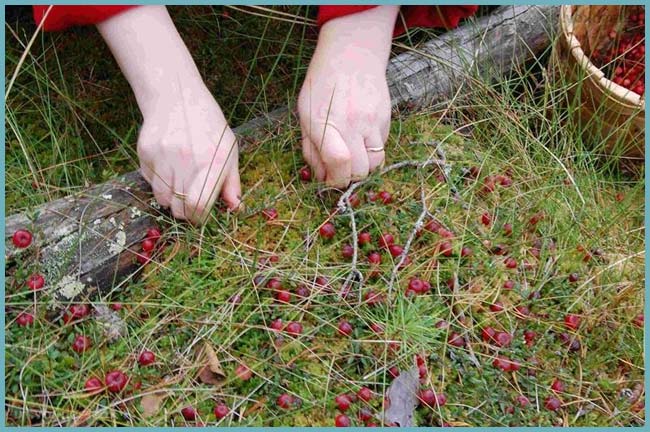

Observe the cranberry watering regime
Cranberries that have reached the age of four, and, accordingly, are already actively yielding crops, must be periodically mulched with peat chips or coarse sand (layer thickness - about 2 cm).
Pruning cranberries is an important process for the formation of the plant's bushes. It must be carried out at the end of spring, during the first three years. The shape of the bushes can be of two types: compact and spreading. To create compact tall bushes, you need to cut off all the thin and creeping shoots on the ground; to create spreading bushes, on the contrary, it is necessary to stimulate the formation of horizontal creeping shoots.
What to do with the grown berry and how to deal with parasites?
After 3 years, the entire area will be completely covered with plant shoots, which complicates the process of pollination and harvesting. In addition, pests settle in such a "fur coat". Often such creeping shoots drown out vertical ones, and it is on them that flowers and fruits are formed. Mulching with coarse sand will solve this problem. We repeat the procedure every 3 years. The thickness of the sand layer should be about 20 mm. As a preventive measure, you can sprinkle the frozen soil a little with coarse river sand.
During the first three years of a plant's life, it is especially important to feed it with minerals. This will have the most favorable effect on the growth and development of young shoots. It is enough to repeat the procedure 2 times a year. At the same time, the dose of fertilizers decreases every year. For the first few years, shaping pruning can give the shrub the desired look. This is very often used in landscape design. But remember that cranberries over 4 years old do not tolerate shortening well.
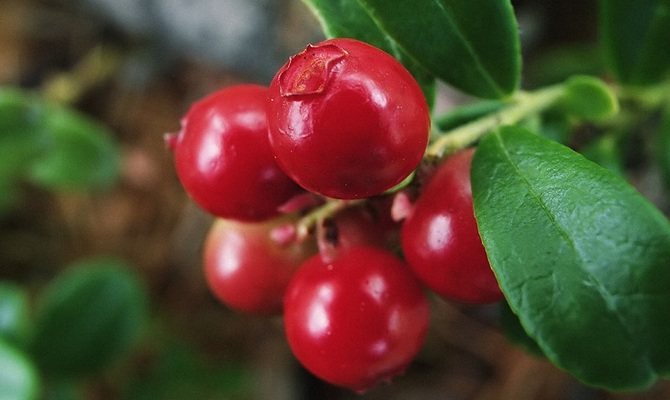

Cranberries
To make the shrub more fluffy, it is necessary to shorten the vertical shoots by 1/3 in early spring, but by cutting the horizontal branches, you can give it a more spreading shape. In the latter case, the harvesting procedure will be greatly simplified.
Snow mold is considered one of the most dangerous diseases of cranberries. It can be calculated by the leaves and buds, which have a reddish-brown color in early spring. But after a few months they turn gray and fall off. Gray mold quickly infects closely growing shrubs, and if you do not take action in time, you can say goodbye to all the cranberries. You can fight the fungus by spraying. The drug Fundazol has proven itself well. Representatives of the flora are processed in the fall.You can also freeze cranberries. To do this, it is necessary to fill the plot with water with the onset of frost and add a little liquid throughout the winter to increase the layer of ice.
If the tops of the shoots turn brown and dry, then you need to take measures to combat the monilial burn. Dark brown, round spots on the leaves and cracking of the bark indicate that the cranberry is affected by ascochitis. In the fight against the first disease, Bordeaux mixture, Horus and Mikosan-V preparations are effective. If for some reason the plant was not treated, then the affected shoots should be removed and burned. To overcome ascochitis, sprinkle the affected areas with a mixture of chalk and sulfuric copper. All fallen leaves must be burned.
Top dressing and fertilization of cranberries
To ensure the active growth of young bushes, the soil must be regularly saturated with fertilizers. Since spring, the greening berry must be fed with full mineral fertilizer.
Advice. When introducing fertilizers and top dressing into the soil with growing cranberries, remember: it is better not to feed than to overfeed. Cranberries will calmly tolerate a lack of fertilizers, but not an excess of them.
If you have an annual cranberry growing, then a few weeks after sowing, you need to feed it. Fertilizer Universal is suitable - 1 teaspoon per 1 sq. m. soil. By the end of summer and then by the middle of autumn, fertilizer Autumn is applied to the soil - 1 teaspoon (incomplete) per 1 sq. m. This feeding scheme is observed until the fourth year of the plant's "life". And in the fourth year, the amount of fertilizer applied should be reduced as much as possible to 5-6 dressings for the entire growing season (1 incomplete tsp per 1 sq. M.).
Description of garden cranberry
The evergreen graceful subshrub cranberry with red sweet-sour fruits belongs to the lingonberry family and is widely known as a northern berry growing in the bogs of the Leningrad region. It is not for nothing that this plant is considered a storehouse of valuable food and medicinal substances, its fruits, which are somewhat like cherries, contain vitamins A, C, B1, B2, PP, K and such substances useful for the body as thiamine, riboflavin and niacin. Blueberries and blueberries are members of the lingonberry family, the fruits of which are of great nutritional value.
Fresh articles about garden and vegetable garden
Cucumber diseases: description with photos and treatment methods
Diseases of the rose photo and how to treat
Diseases of tomatoes: photos and their treatment, from what leaves curl?
Garden cranberries are considered large-fruited because of the large beautiful berries, the size of which varies from 15 to 25 mm, which is three times more in diameter than the fruits of the common marsh. Shrubs of the plant produce shoots of a horizontal and creeping type, the length of which depends mainly on their variety and can be from 50 to 115 cm.Fortunately, garden cranberries are perfectly adapted for planting and growing in simple garden plots and vegetable gardens, and are also completely unpretentious and unpretentious in care.
Caution: diseases and pests
After the crop is harvested, the plant must be protected from both diseases and frost and the possible lack of snow. As soon as the temperature is stable at below zero (-4-5 degrees), it is necessary to fill the cranberry with a two-centimeter layer of water. When it freezes, fill it again with the same layer. Repeat the steps until the cranberries are completely hidden under water. It is important that all layers are completely frozen.
Advice. If the climate in your region is too mild and frosts are rare, just carefully cover the cranberries with spruce branches.
To prevent the development of fungal diseases due to the plant being in moist soil, at least 3-4 times during the entire growing season, cranberries must be treated with fungicides.In the spring, when the buds begin to actively bloom, the plant must be sprayed with Bordeaux liquid (1%).
It should be noted that cranberries are a "tough nut to crack" for pests. They will not be able to do almost any harm to the plant if they are regularly looked after (especially with regard to removing weeds from the soil). The use of insecticides for pest control is an extreme measure that can be carried out no later than a month and a half before picking berries.
Consider several of the most dangerous diseases for cranberries:
- Gray rot. The disease appears in cool, wet weather. The largest stems and leaves of the plant are covered with a gray fungal bloom. Method of struggle: treatment of the plant with chlorine oxide or Bordeaux liquid.
- Cytosporosis. The causative agent of the disease enters the plant through its small wounds and affects it with black rot. The method of struggle is the same as with gray rot (always at the beginning and at the end of the growing season).
- Terry (overgrowth). This is a virus. Affected shoots rise up, and the leaves shrink and adhere to them. "Sick" cranberry bushes do not bear fruit, and if the first berries have already appeared, they will grow small and ugly. There is still no method to combat this disease, so the diseased plant is simply removed from the soil and burned.
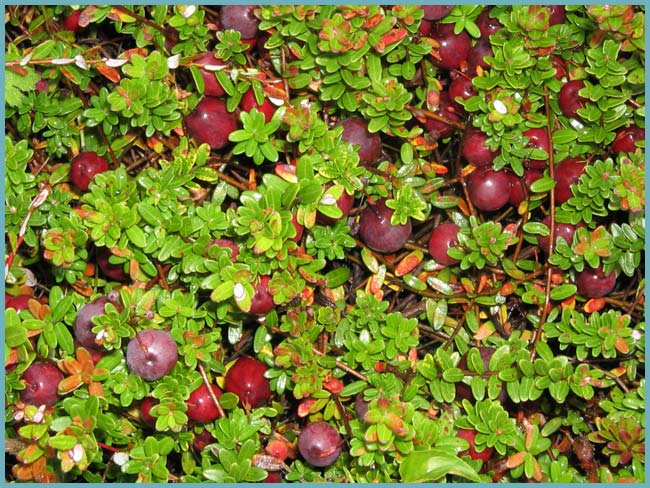

For the winter, cranberry bushes need to be covered
Seasonal pruning of the bush
Cranberries need to be pruned periodically. By the 5th year of life, the shrubs grow strongly, as a result of which illumination is poorly received, the quality of the harvest deteriorates (the berries become lighter and smaller). A haircut is also needed to form a neat fluffy crown and timely remove areas affected by a pest or fungus. Bushes thin out the entire growing season, but spring and autumn pruning is planned.


In the spring
With the onset of the thaw, they remove the shelter and examine the bush for damaged or frozen shoots, which are immediately cut off and burned. It is necessary to prune before the start of sap flow and swelling of the kidneys. You should also prune the creeping shoots that protrude above the erect stems so that the shrub will look more fluffy and even, without protruding stems.
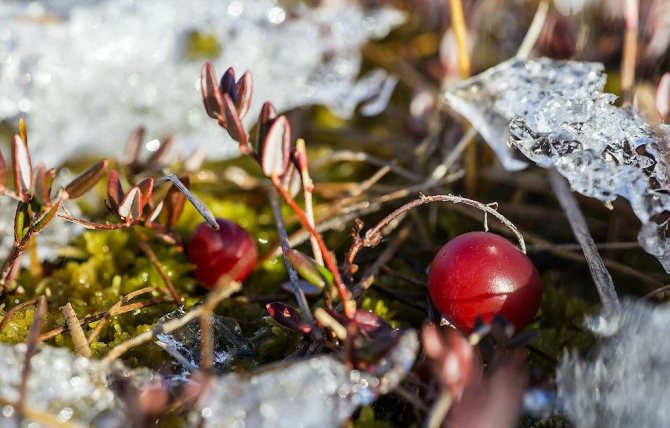

In autumn
After harvest (in October), a second scheduled pruning is carried out. The main task is to remove old, weakened shoots that can no longer fully bear fruit. Such branches will pull in nutrients and moisture, which can fertile shoots. It is also recommended to cut the young growth, as it will not have time to grow stronger before frost and will probably not survive the winter.


Combining cranberries with other plants
Since cranberry is a plant pollinated by bees, you will do yourself a favor if you plant honey plants next to it - oregano, thyme, etc.
Cranberries grow in an acidic and humid environment, and, naturally, next to it it is impossible to grow traditional and beloved crops such as representatives of the nightshade family, cabbage, etc. But there is an excellent combination of the plant with lingonberry, sedge, wild rosemary.
Harvesting is carried out in early autumn, when the fruits are not yet ripe. They will ripen during storage.
Our material is coming to an end. Now you know about all the intricacies of growing cranberries in your summer cottage. By following the tips given in the article, you can grow a beautiful plant, which will subsequently delight you with a rich harvest. Good luck!
Where it grows in Russia
Cranberries are found in the European part of Russia. The plant also grows widely in Siberia, Karelia, Sakhalin and Kamchatka. The area of distribution of culture - from the border of the Arctic Circle in the northern latitudes to the end of the swampy area in the south (approximately 62nd parallel).
If you decide to go in search of wild cranberries, head to swampy regions and forests.Equip yourself with protective clothing and a berry picker for a rich and tasty harvest.
Growing cranberries: photo
Determination of soil acidity
In industry, the acidity of the soil is determined by a special device - an acid meter. There are 2 simple ways to determine acidity:
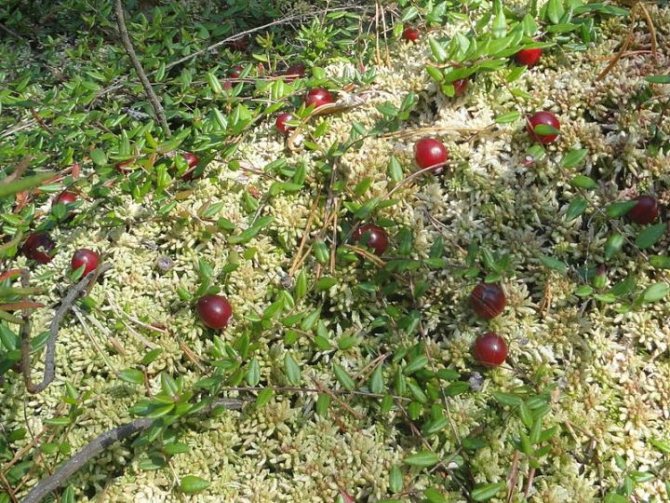

- A handful of cooked earth is scattered with table vinegar. The appearance of a specific boil and small bubbles indicate a weak acidity. Acidic soil does not react with vinegar.
- Lower the soil in 200 ml of grape juice. With a high acidity of the soil, the juice remains unchanged, with normal or low acidity, it darkens and bubbles.
You can give the optimum acidity (pH 3.5–5.5) by watering the garden bed with acidified water (1 tsp. Citric or oxalic acid, or 1 cup vinegar per bucket of water). The electrolyte for acid batteries is also used (50 ml of the product per 10 liters of water).
Harvesting and storage
You can harvest at different times. In the spring, fruits that grow in the natural environment are harvested. After overwintering, they become sweeter.
If cranberries are needed for long-term storage, they are harvested when they are fully ripe. Technical ripeness lasts from late August to early November.
An unripe berry, lying down, will acquire the color of ripe fruits.


Harvesting can be done manually or with scrapers. The second method is easier, but injures the plant, which is undesirable. In order for the berry to survive longer without processing, it is better to harvest in dry, sunny weather, after the morning dew has dried.
Large farms harvest in a different way. Checks are filled with water, fruits float to the surface. After that, it's pretty easy to assemble them.
Until the next harvest, ripe fruits can be preserved by flooding it with water, after which they can be placed in the cellar. It turns out the cranberries are soaked, and if you also add sugar and a little vinegar, you get a pickled berry. This will increase the shelf life.
Without water, cranberries can be stored for up to 3 months. At home, it is placed in plastic containers and placed in the refrigerator or stored in wooden boxes in the cellar at a temperature of 0-8 ° C.
Fruits harvested in spring are best processed or frozen. Before freezing, the fruits are washed and dried.
When frozen, the berries are laid out in containers or bags, taking into account their use at a time. Re-freezing leads to a decrease in quality and loss of useful properties.
Frozen berries are used to make desserts, compotes, jelly, added to sauerkraut.
Jam is made from fresh fruits, ground with sugar.
Cranberry Healing Recipes
Cranberries are used in the treatment and prevention of various diseases, recipes include the use of juices, decoctions, tinctures and cranberry extract.
With a cold
- take the juice of cranberry, aloe, lemon, honey and vodka in equal amounts. Mix and take 20 ml. three times a day. It is useful to drink cranberry juice and juice.
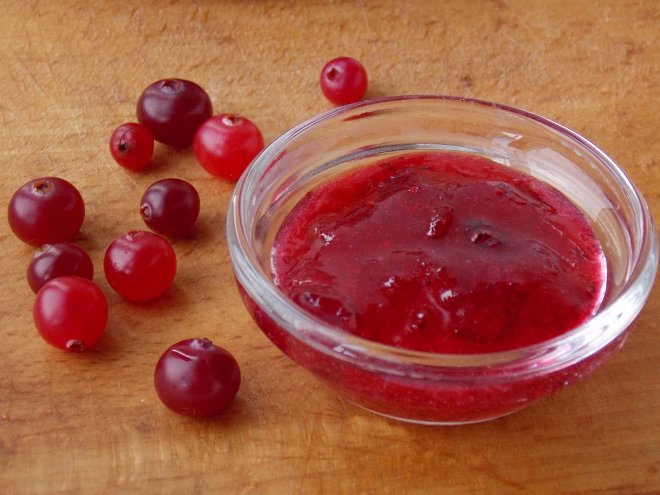

cranberries, mashed with sugar, is an excellent therapeutic and prophylactic remedy for many diseases
With hypertension
- take 0.5 kg. cranberries and 150 gr. sugar, dilute 1 \ 4 liters of water. Cook over low heat for 10 minutes, dilute with half of water and drink a glass a day.
To cleanse the intestines
- cranberry juice is mixed with beet juice in equal quantities and drink 1/4 cup three times a day. Helps cleanse the intestines from stagnant feces, relieves constipation and spasms.
With physical weakness
- cranberry juice is diluted in half with water and taken to fortify the body and restore physical strength. The drink gives vigor and is useful for people engaged in hard physical labor and sports.
With diabetes
- add 1/4 liter of boiling water to crushed cranberries (100 gr.), Let it brew for an hour. Take 50 ml. up to 2 times a day.
For diarrhea
- take cranberry leaves and berries in equal amounts, add half a liter of water, keep on low heat for 5 minutes. Take up to 4 times a day for 1/2 cup.


the berry has an immunostimulating and strengthening effect on the human body
With immunodeficiency
- put a handful of dried or frozen berries in a thermos, add boiling water, let it brew. It is taken warm with sugar or honey.
With angina
- juice is squeezed from fresh cranberries, honey is added. The tool has an antibacterial, anti-inflammatory and anti-cold effect.
For joint pain
- take garlic and cranberry juice in equal proportions, insist for a day. Add honey, mix and use tsp. before meals three times a day.
How cranberries reproduce
Garden cranberries are propagated by seed method or cuttings. Planting seedlings was described above. The disadvantage of this method is the frequent loss of the properties of the parent variety during self-collection of seeds. For better preservation of varietal qualities, the culture is propagated by cuttings.
The propagation procedure by cuttings is as follows:
- In June, during flowering, shoots from 8 to 15 cm long are cut from the bushes.
- The tips of the cuttings are dipped into the rooting machine.
- Then the planting material is planted in a mixture of sand and peat to a depth of 3-4 cm.The distance between adjacent seedlings should be 5 cm.
- After planting, the containers are placed in a well-lit room.
Cranberry cuttings take root in 25-30 days. After about 60 days, they can be planted outdoors.
Application
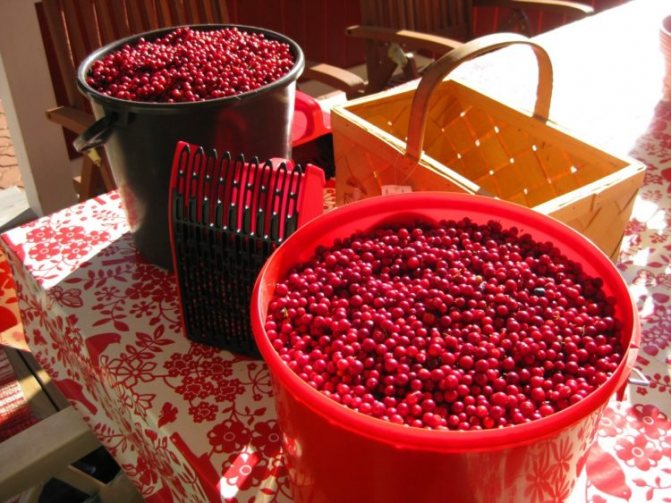

Typing in the search engine the query "cranberry photo berry", be sure to take a look at how you can use the berry in everyday life. Next, we will describe several variations in the use of cranberries in everyday life.
In cooking
In this case, delicious red berries are most often added to salads, sauces, baked goods and various additives. The berry's taste is extraordinary, and allows you to experiment with a wide variety of flavor combinations.
In medicine
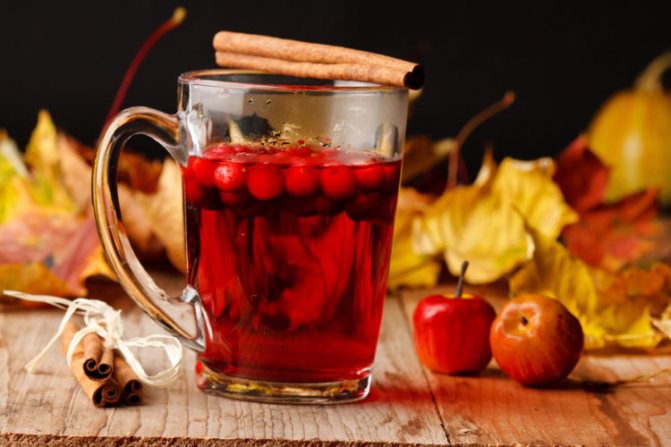

As practice shows, the cost of cranberries on the market is very high. This is partly due to the fact that berries have a rather serious effect on our body. Regular consumption of berries guarantees:
- significant reduction in cholesterol levels;
- preventing the formation of blood clots;
- strengthening the walls of blood vessels;
- increased efficiency;
- neutralization of inflammatory processes;
- prevention of the formation of atherosclerotic plaques.
In cosmetology
Often, red berries can be found in well-known cosmetic preparations. A large amount of minerals in the berry helps to rejuvenate the skin, increase elasticity and fight the first signs of aging.
The history of cranberry cultivation
In the early 19th century, Henry Hall, from near Massachusetts, noticed that cranberries, sprinkled with sand, bear fruit much better.
He took up a shovel, hauled sand under all the bushes in his neighborhood and got an unprecedented harvest. As a result, the Massachusetts cranberry thundered all over America and laid the foundation for the mass cultivation of this berry.
Currently, hundreds of species of this berry have been bred in the United States, it is grown on their plots as a family business and on an industrial scale.
Local experts bred large-fruited cranberries with an air chamber, thanks to which they do not sink.
When the time comes for harvesting, bubbling water is forced into the plantation, which tears the berries from the stalk. They float up and are driven into special compartments, from where the cranberries are caught with industrial ladles.
In Russia, they became interested in large-fruited cranberries at the end of the 19th century in the St. Petersburg Imperial Botanical Garden. A group of scientists was engaged in research, but after the death of the director of the botanical garden E. Regel, funding stopped and a good undertaking stalled.
They returned to this only in the 70s of the last century. Plantations of large-fruited cranberries appeared in several Union republics at once.
The most serious approach to this matter was approached in Belarus, and after the collapse of the USSR, it was this country that went ahead by leaps and bounds, continuing to create and equip new plantations with modern equipment.
In our country, large-fruited cranberries are grown only in the village of Miskovo near Kostroma and more than 100 tons are harvested there per season.
Basically, we collect marsh cranberries.
Interesting Facts
- Despite the fact that cranberry bushes are always small, one such can produce at least 200 berries in 1 year.
- The berry is called lingonberry for a reason, because lingonberry is its most frequent neighbor in nature. In the literal sense, the Latin name of the fruit can be translated as "sour".
- Cranberries are a natural antidepressant and are good at relieving stress.
- The most popular and largest berry producer in the world is the United States of America. Canada, Poland and Belarus are also competing for the championship.
- There is a variety that does not sink in water. Among the berries, this is a truly unique trait used by farmers. It is enough to flood the plantation before harvesting and let the berries float, and then use special machines to complete the harvest.
- Water is the basis of lingonberry. It consists of almost 90 percent of it.
- Ripe berries are checked in a rather interesting way: they are thrown onto the countertop. If they jump, then the fruits are ripe.
- Cranberries are the record holder for longevity. The bush of the plant can live for 100 years.
- At the same time, this plant can set a record in height, as some specimens reach one and a half meters.
- The Indians used a mixture of cranberries to preserve dried meat.
- The berry is a symbol of the American state of Massachusetts and the Besenburen commune in Switzerland.
Useful properties for the body


cranberries and drinks with it will have a positive effect on maintaining women's health
Useful properties for women
The healing properties of cranberries will help a woman lose weight, thanks to the action of breaking down fats. They will have a cosmetic effect - they will improve the condition of the hair, remove split ends, and strengthen the nail plates. Berries are the prevention of cystitis and other problems of the genitourinary system.
Useful properties during pregnancy
The berry and drinks from it replenish the body of the expectant mother and baby with the necessary mineral and vitamin complex, increase the body's immunity and resistance to the development of infections, relieve symptoms of toxicosis, swelling and pressure surges.
What are the benefits for men
The benefits of cranberries for men's health are invaluable, you need to eat fresh berries and drink freshly squeezed juice. This will reduce the risk of prostatitis and prostate adenoma, the development of genitourinary infections.
Benefits for children
During the off-season and epidemics, vitamins in cranberries will help the child cope with colds, relieve fever, fever, inflammation, and have a diaphoretic effect. The berry has an effective antiseptic effect, inhibits the development of microbes, bacteria, viruses, fungus. It is an antitussive agent, improves the functioning of the stomach and intestines, eliminates dysbiosis. From 6 months, the baby can be given juice squeezed from two berries and diluted in half with water, as well as fruit drinks, compotes, jelly.
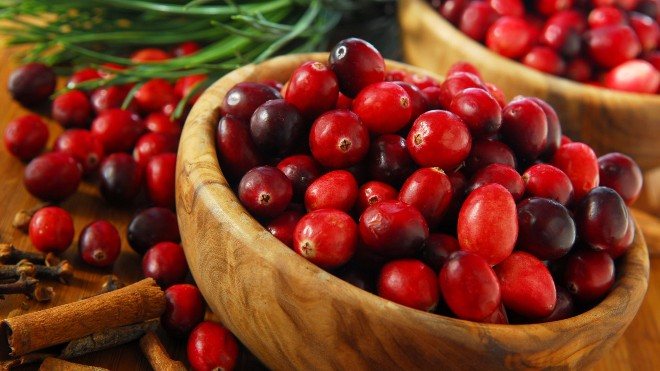

due to its rich chemical composition, the berry has a lot of positive effects on the human body
Where to get planting material
It is recommended to purchase planting material in specialized nurseries, which provide a guarantee of belonging to the variety. Plants with open and closed root systems can be planted. Saplings of 3 ages are on sale:
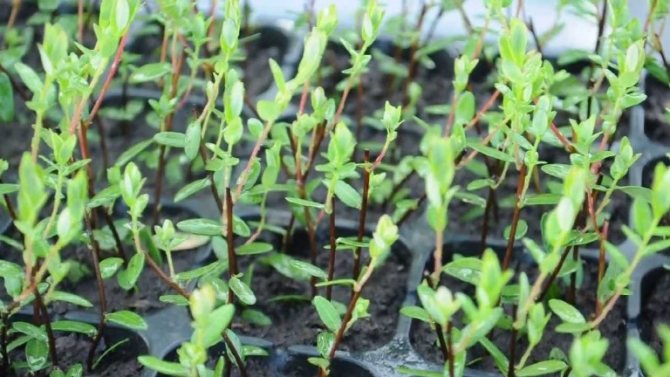

- Young plants, which are 7-9 months old. They are sold in special cassettes and require growing;
- Saplings 1-1.5 years old, planted in separate pots;
- Adults are 2-2.5 years old.
The first crop of cranberries gives at the age of 3-4 years. If there is a desire to accelerate fruiting, it is worth giving preference to adult specimens, but they are more expensive.
When to harvest cranberries
We must start with the fact that you can collect white-sided cranberries, but you cannot. It won't ripen anyway.
Of course, it is better to collect when it is ripe. In our large country, this happens in different ways, from mid-September to late autumn.
The temperature is also different every year, so the best option is to see if they are selling it in the local market or ask fellow berry growers.
Read also How many calories are in potatoes with chicken
Lovers of sweeter cranberries can continue their quiet hunt in the spring when the snow melts. "Snowy" or "vesnyanka", as it is popularly called, tastes less bitter, but it also contains fewer vitamins.
It will not work for a long time to store cranberries that have overwintered in a swamp; over the winter they lose reserves of their preservative, benzoic acid.
Ripening of cranberries after harvest
It is necessary to ripen red and white-sided cranberries at home as follows:
- Take a cardboard box and cut a lot of holes in it.
- Place a sheet of paper on the bottom of the box and place the cranberries on top of it. We throw away the rotten and green ones right away, until they spoil the other berries.
- Put another sheet of paper on the first layer of berries and sprinkle cranberries on it again, then the next sheet and so on to the top of the box. In this whole process, the most important thing is to make more holes and put them in a ventilated room.
- After a month, we disassemble our structure and remove the rotten berries.
You can accelerate the ripeness of the harvest by placing a ripe tomato or apple in a container where a berry is stored: these fruits release ethylene and cranberries ripen faster.
Reproduction by layering
To propagate cranberries by layering, gardeners do not need to make any effort. The plant independently lowers several stems to the ground, which take root after a while. The only requirement for such reproduction is a well-moistened soil. If you want to speed up the propagation of cranberries by layering, you can press a few stems to the ground with wire.
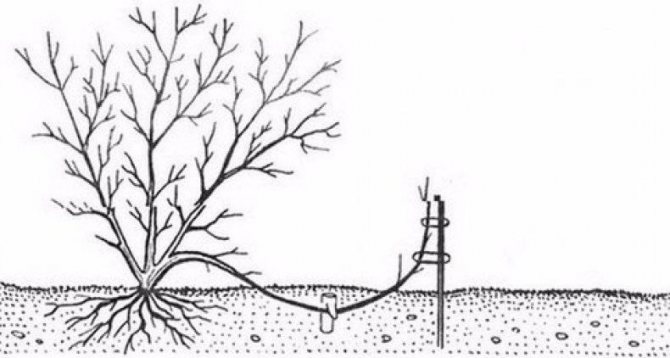

Cranberry habitats
Cranberries are a berry that loves moisture and does not tolerate a polluted environment. This plant is very sensitive and selective - it will not live anywhere. Therefore, in the immediate vicinity of places of human activity, you will not find cranberries in the daytime with fire. She loves swampy areas hidden from the eyes of people, wet lowlands, and sometimes it is found on the hills, in the foothills. The main requirements for cranberries are high humidity and fertile soil.
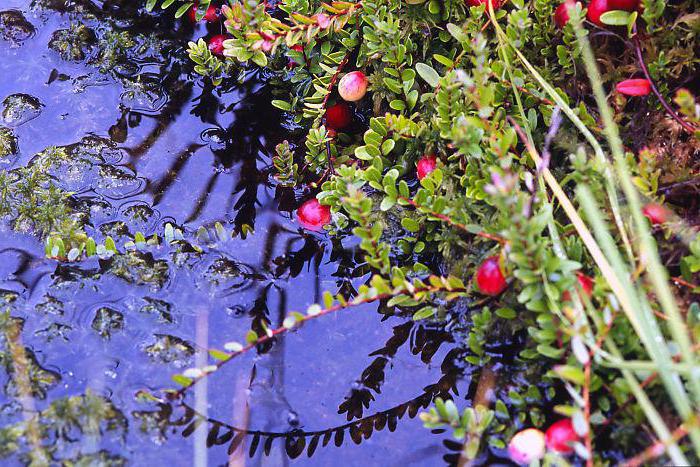

The largest thickets of berries are found in central Russia, in the north of the country and in Siberia, as well as in Belarus, in the north of Ukraine and France, in Canada and the northern states of the United States.
Of the three types of cranberries (large-fruited, small-fruited and ordinary) on the territory of the Russian Federation, only the last two can be found. The common marsh cranberry is more common - it is found everywhere, excluding the southern regions of the country.
What is in the berry
Cranberries are popularly called "the storehouse of vitamins". And all because of its useful elements. For example, the content of ascorbic acid or vitamin C in cranberries is identical to that in citrus fruits.
The presence of vitamin C in the berry makes it possible to prolong its preservation when wet.
Cranberries are rich in a set of various trace elements: calcium, iron, selenium, molybdenum, magnesium, phosphorus, iodine and many others. In addition to these elements, the content of sugars is high: glucose, sucrose, fructose. But in terms of potassium content, cranberries take 1st place among other fruits and berries.
When is cranberry harvesting officially allowed?
In the period from the 1980s to 2000, each region of the Russian Federation got a regional Red Book, where rare species of plants and animals are noted every ten years.
Cranberries also came under the protection of the regional ministry of nature or regional forestry / economy departments.
On the official websites of these regional organizations, they often write from what date it is possible to harvest cranberries and emphasize that the preparations should be intended only for personal needs.
Areas and provinces that included cranberries in the list of endangered plants:
Cranberry picking is more often allowed from a certain date (usually from September 7-10), the dates change every year - it depends on the conditions of a particular area.
When appropriate conservation measures were taken, the condition of the species in the swamps stabilized.
Marsh cranberry is a useful berry that is used to treat many diseases. However, in order for it to reveal all its medicinal properties, you need to know where to collect it, when and how to do it correctly.
The healing properties of cranberries
The benefits of cranberries for the human body are enormous:
- Potassium and B vitamins contained in the berry normalize the nervous system and stimulate mental abilities;
- Relieves symptoms of colds, inflammation, fights viruses and microbes, enhances the effect of antibiotics;
- Increases immunity and body defenses during flu and colds, is a prophylactic agent;
- Improves the function of the gastrointestinal tract, intestinal motility, eliminates heartburn, increases appetite;
- Cranberry treatment helps to eliminate infections of the genitourinary system and has a diuretic effect;
- Cranberry in oncology, due to its antioxidant properties, inhibits the growth of cancer cells and is a preventive measure for the appearance of oncology;
- Reduces cholesterol levels, prevents the formation of cholesterol plaques, normalizes blood pressure, helps in the treatment of cardiac and vascular pathologies;
- Cranberry leaves have medicinal properties, a decoction of them has an antibacterial effect. They treat wounds, gargle with sore throat. Tea with leaves helps to cleanse the body of toxins and toxins.
Content
- Description
- Planting cranberries When to plant
- Planting in spring
- Planting in autumn
- Spring care
- When to trim
- How to propagate
- Beneficial features
Cranberries in medicine
The berry was widely used thanks to dermatologists. It is often used by mouth to treat psoriasis. Cranberry juice helps to heal burns, wounds, and lichen. The use of the concentrate is indicated for head lice. Dentists recommend using the fruit to treat periodontal disease and strengthen the gums. It can be used to make whitening masks or creams that have a beneficial effect on greasy skin. To prepare a rejuvenating mask, it is enough to add olive oil, sour cream and wheat flour to cranberry juice.
Etymology of the name
The scientific name of the Cranberry is Oxycoccus, which is translated from Greek as "Sour Berry". Indeed, Cranberries taste rather sour.
We recommend related posts:
Crocuses - description, planting and care in the open field
Calla lilies - description, planting and care in the open field
In different countries, this plant is called differently. For example, in America it is called Cranberry, which translates as "Crane berry", and in England - Bear berry, as grizzlies love to eat this berry.
What the Russian name of the berry means is not known. However, in some areas, Cranberry is called Crane, apparently by analogy with the American version.

